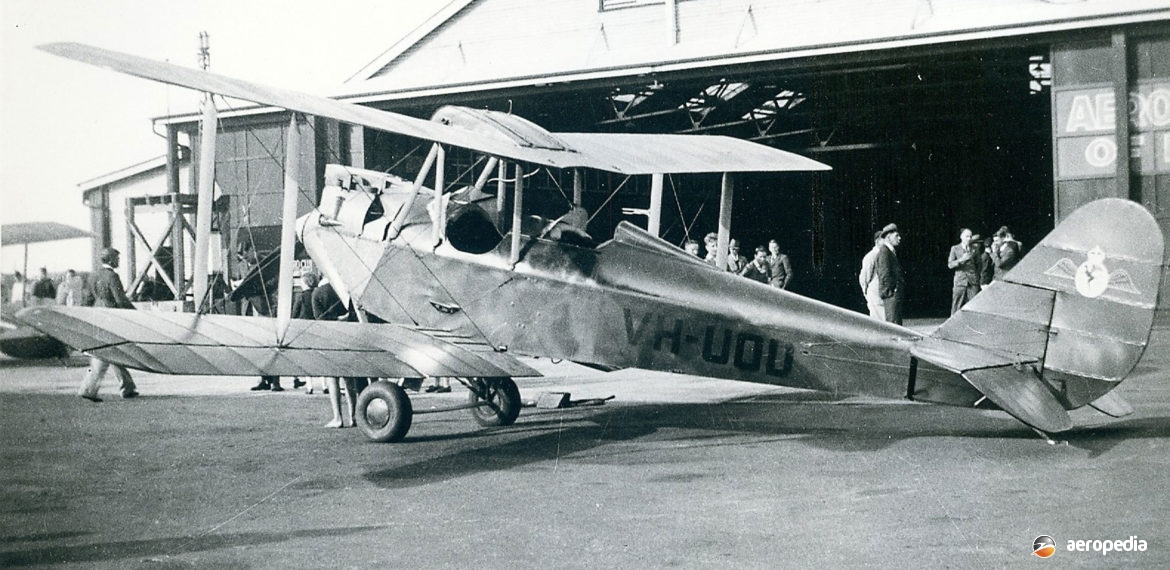Photograph:
Spartan Arrow VH-UQD (c/n 80) at Essendon, VIC in 1931 (Frank Walters collection)
Country of origin:
United Kingdom
Description:
Two-seat light touring biplane
Power Plant:
One 90 kw (120 hp) de Havilland Gipsy II four-cylinder in-line air-cooled engine
Specifications:
- Wingspan: 9.35 m (30 ft 7 in)
- Length: 7.62 m (25 ft 0 in)
- Height: 2.89 m (9 ft 6 in)
- Wing area: 23.31 m² (251 sq ft)
- Max speed: 171 km/h (106 mph)
- Cruising speed: 148 km/h (92 mph)
- Initial rate of climb: 253 m/min (830 ft/min)
- Range: 695 km (432 miles)
- Empty weight: 438 kg (965 lb)
- Loaded weight: 794 kg (1,730 lb)
History:
The British light aircraft manufacturing company, Simmonds Aircraft Ltd, underwent some changes in 1930 and became Spartan Aircraft Ltd, producing aircraft initially at its Weston, Southampton, facility, before moving to East Cowes on the Isle of Wight on 20 February 1931. It developed a new two-seat light touring biplane which used a non-symmetrical wing section but retained many of the systems previously developed such as the detachable wing tips and trailing edge section, these enabling the wing to be fitted on either side, and an aileron at either end. The undercarriage was still interchangeable, but the vertical tail surfaces were of new design.
Structure was still the tried and proven spruce and plywood fuselage, and overall wood construction with fabric covered wings. The wings could be folded for storage, and the cockpits were entered by doors on the side of the fuselage. Some 28 examples were built and a variety of engines installed, including the 82 kw (110 hp) de Havilland Gipsy I, the Gipsy II, the 71 kw (95 hp) ADC Cirrus III, the 78 kw (105 hp) Cirrus Hermes II, and the 119 kw (160 hp) Napier Javelin III.
The prototype G-AAWY (c/n 51) flew for the first time with a Hermes II engine in May 1930, but the first 12 production aircraft had the Gipsy II engine. They became known for their good performance and examples were entered in the King’s Cup Races and the International Round Europe Touring Competition in 1930.
One VH-UQD (c/n 80 – ex G-ABHD) was built for Australian pilot, Mr G P Fairbairn. Fitted with a 78 kw (105 hp) de Havilland Gipsy II engine, it was delivered to the owner on 25 January 1931. He used this machine for an attempt on the England to Australia record but the attempt ended at Nice in France on 20 February. The aircraft was then shipped the rest of the distance. It was returned to Australia and became VH-UQD on 25 June 1931 but was destroyed in a crash at Essendon Aerodrome, VIC on 26 May 1936.
One other machine has been seen in this region being ZK-ACQ (c/n 75 – ex G-ABBE) which, prior to being shipped to New Zealand, underwent tests as a seaplane at Felixstowe in December 1930. It was sold in New Zealand and was erected at Wigram for its new owner, Frank Lysons, in May 1931. It was flown to Blenheim on 31 May but on arrival at the Woodbourne aerodrome it stalled, spun into the ground, and was badly damaged. The wreck was rebuilt at Wellington by A J Dingle and subsequently in 1934 was painted in an unusual colour scheme. It was later sold to Mr M H Oram (later Sir Mathew, Speaker of the House of Representatives) and based at Palmerston North but was destroyed when the roof of the hangar in which it was placed collapsed during gale-force winds on 2 February 1936.

